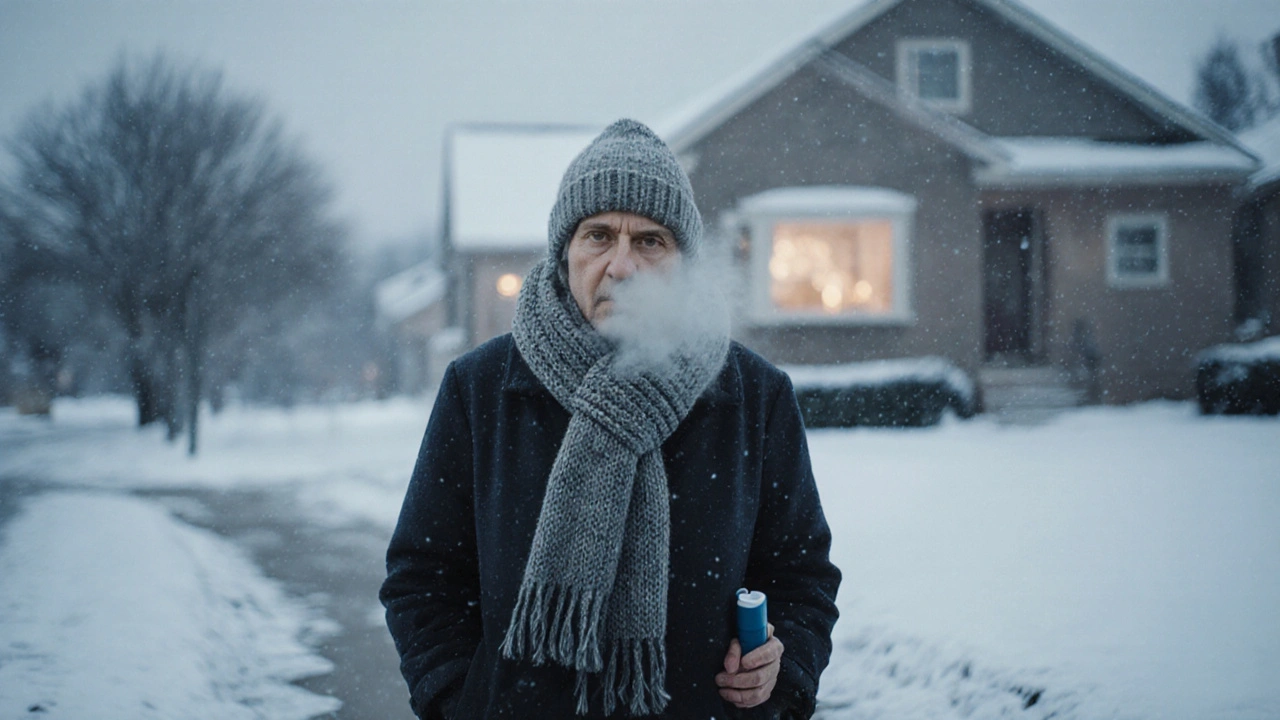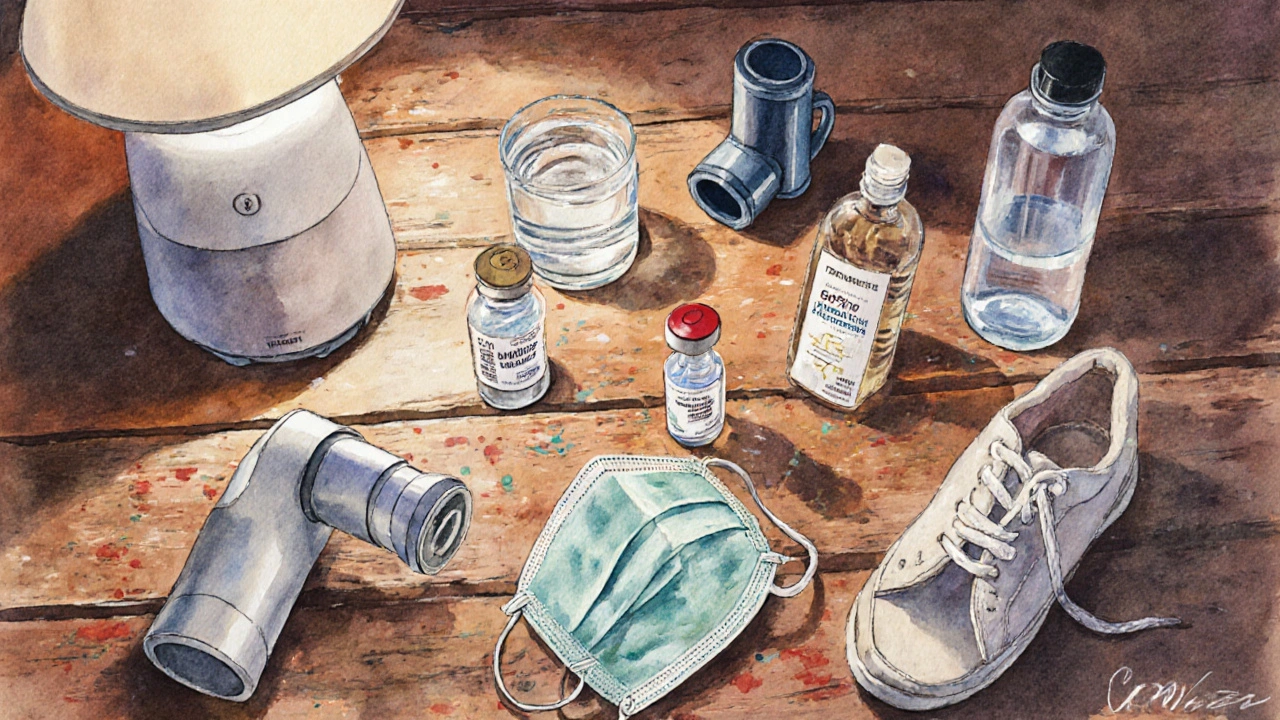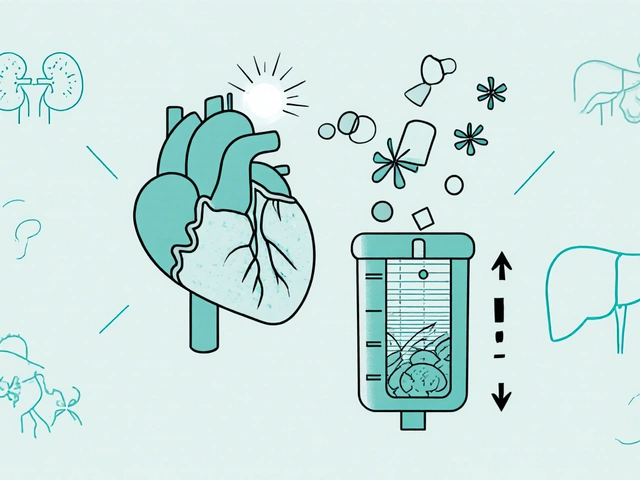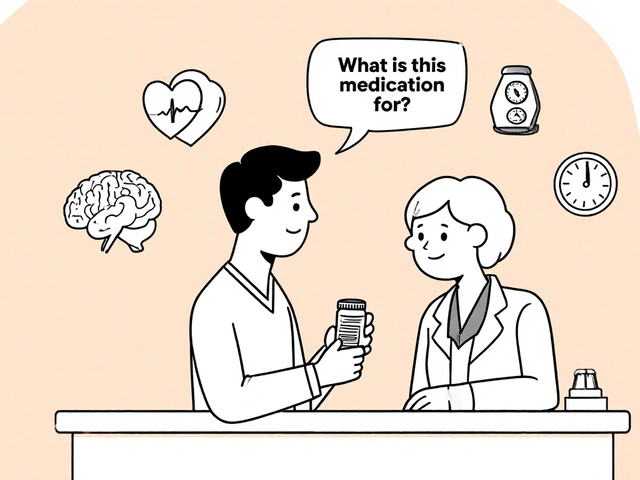
COPD Winter Preparedness Checklist
Prevention Recommendations
Medication Guidance
Warning Signs to Monitor
When winter rolls around, Obstructive Pulmonary Disease a chronic lung condition that blocks airflow and makes breathing difficult becomes a real headache for many. The drop in temperature, crowded indoor spaces, and the surge of viruses mean you’re more likely to catch a cold or the flu, which can quickly turn into a serious COPD flare‑up.
Why Cold and Flu Season Threaten Your Lungs
Viruses such as Influenza an acute respiratory infection that spreads easily in winter months and the Common Cold a milder viral infection of the upper airway inflame the airways, increase mucus production, and raise your body’s oxygen demand. For someone with obstructive pulmonary disease, even a small dip in lung function can feel like a major crisis.
Studies from the Global Initiative for Chronic Obstructive Lung Disease (GOLD) show that up to 50% of COPD hospitalizations occur during the December‑February window, and viral infections are the leading trigger.
Build a Prevention Toolbox Before the First Sneeze
Prevention isn’t magic; it’s a set of habits you can start today.
- Get the flu vaccine. The Flu Vaccine an annual injection that teaches your immune system to recognize influenza viruses cuts your risk of catching flu by about 40‑60% and reduces severity if you do get sick.
- Wash hands frequently with soap and water for at least 20 seconds. When soap isn’t handy, use an alcohol‑based hand rub containing at least 60% alcohol.
- Avoid close contact with anyone showing cold or flu symptoms. If you must be around them, wear a simple surgical mask.
- Keep your home humidified (30‑40% relative humidity). Moist air helps keep airway mucus thin and easier to clear.
- Stay up to date on other vaccinations-pneumococcal, COVID‑19, and pertussis-because co‑infections are especially dangerous.
Medication Management When You Feel Under the Weather
Your regular COPD regimen probably includes a Bronchodilator Inhaler a device that delivers medication to relax airway muscles quickly and an Inhaled Corticosteroid a medication that reduces chronic inflammation in the lungs. When a virus hits, you may need to tweak dosages.
Here’s a quick checklist:
- Continue your maintenance inhaler exactly as prescribed-never skip a dose.
- Use your rescue Bronchodilator Inhaler at the first sign of wheezing or shortness of breath. If you need more than two puffs in 24hours, that’s a red flag.
- Talk to your doctor about a short‑term oral steroid burst if symptoms worsen rapidly.
- If you test positive for influenza, discuss starting an Antiviral Medication such as oseltamivir, which can reduce flu severity when given within 48hours of symptom onset.
Know the Warning Signs of a COPD Exacerbation
Spotting trouble early can keep you out of the emergency department. Watch for:
- Increased shortness of breath that doesn’t improve with rescue inhaler.
- New or worsening cough with thick, discolored sputum.
- Fever above 100.4°F (38°C) that lasts more than 48hours.
- Confusion, rapid heartbeat, or a sudden drop in oxygen saturation (below 90%).
If any of these appear, call your healthcare provider or go to the nearest urgent care facility. Having an action plan written down and shared with family members makes the response smoother.

Home‑Care Strategies to Stay Comfortable
While you’re fighting off a virus, these home measures can make breathing easier:
- Stay well‑hydrated-water, herbal tea, and clear broths keep mucus thin.
- Elevate the head of your bed by a few inches to reduce nighttime coughing.
- Use a cool‑mist humidifier for 30‑45 minutes a few times a day; clean it daily to avoid mold.
- Practice pursed‑lip breathing: inhale through the nose for two counts, exhale slowly through pursed lips for four counts.
- Gentle stretching or a short walk (if you feel up to it) helps prevent deconditioning.
Long‑Term Support: Pulmonary Rehabilitation and More
Even when you’re feeling well, Pulmonary Rehabilitation a supervised program that combines exercise, education, and breathing techniques for people with chronic lung disease can boost your stamina and teach you how to handle future infections.
Typical components include:
- Endurance training (treadmill or stationary bike) tailored to your baseline oxygen levels.
- Strength training for the upper body, making inhaler use less tiring.
- Education sessions covering vaccine schedules, inhaler technique, and nutrition.
- Psychosocial support-depression and anxiety are common in COPD and can worsen outcomes.
If you haven’t enrolled yet, ask your pulmonologist for a referral; many programs now offer virtual sessions, which are handy during flu season.
Compare Your Inhaler Options
| Feature | Rescue (Bronchodilator) | Maintenance (Inhaled Steroid + Long‑Acting Bronchodilator) |
|---|---|---|
| Primary Goal | Quick relief of sudden breathlessness | Reduce chronic inflammation and keep airways open |
| Typical Onset | Within 1-3 minutes | 2-4 hours for full effect |
| Frequency of Use | As needed, not more than 2‑4 puffs per episode | Twice daily (or as prescribed) |
| Common Active Ingredients | Albuterol, Levalbuterol | Fluticasone, Budesonide, Salmeterol, Formoterol |
| Side‑Effects | Tremor, rapid heartbeat | Hoarseness, oral thrush (use spacer and rinse mouth) |
Putting It All Together: Your Winter Action Plan
Write down the following items and keep the sheet on your fridge:
- Vaccination dates (flu, pneumococcal, COVID‑19).
- Contact numbers for your pulmonology clinic, local urgent care, and a trusted family member.
- List of current medications with dosage instructions.
- Signs that mean you need to call a doctor right away.
- Supply checklist: inhalers, spacer, hand sanitizer, thermometers, antiviral prescription (if prescribed).
Having a ready‑to‑go plan reduces anxiety and speeds up decision‑making when symptoms appear.
Frequently Asked Questions
Should I stop my inhaled steroids if I get a cold?
No. Inhaled steroids are the backbone of COPD control and should be continued even during a cold. Stopping them can lead to increased inflammation and a higher risk of exacerbation.
Can the flu vaccine cause COPD flare‑ups?
The flu vaccine is made from inactivated virus particles, so it cannot cause flu or trigger a COPD flare‑up. The mild soreness at the injection site is the most common side‑effect.
How long should I use an antiviral like oseltamivir?
Standard courses last five days, but your doctor may extend it to ten days if you have severe COPD or a worsening respiratory status.
Is a home humidifier safe for someone with COPD?
Yes, as long as you keep the humidity between 30‑40% and clean the device daily to prevent mold growth, which could worsen symptoms.
When should I consider oxygen therapy during a cold?
If your resting oxygen saturation consistently falls below 88% or you feel dizzy, confused, or short of breath at rest, start supplemental oxygen and seek medical attention immediately.
By combining vaccination, meticulous medication use, early symptom detection, and a solid action plan, you can ride out the cold and flu season without letting your lungs take a hit. Remember, the goal isn’t just surviving the winter-it’s staying active, breathing easier, and enjoying the holidays with the people you love.
Obstructive Pulmonary Disease doesn’t have to dictate your winter; with the right prep, you control the season, not the other way around.




18 Comments
Great, another winter where my lungs get to audition for a drama series.
I totally get how stressful the cold months can be for anyone with COPD you deserve all the support possible and remember you’re not alone in this journey it’s okay to ask for help and lean on friends and family you’ve got a solid plan here and that’s already a big win keep breathing and stay hopeful.
Winter is just nature’s way of testing our resilience, isn’t it? Yet you keep thriving, despite the cold conspiracies lurking in the air!
Love the checklist! 😊 Keeping those inhalers handy and the humidifier running will make the season way easier. Stay safe! 🌬️
They don’t tell you in the mainstream that the flu shots are part of a larger agenda to monitor populations, but hey, if it keeps the viruses at bay, why not take advantage of the free vaccine? Stay vigilant, stay healthy.
Here’s the science: maintenance inhalers contain corticosteroids that reduce airway inflammation, while rescue inhalers deliver bronchodilators for rapid relief. Skipping doses will only elevate the risk of an exacerbation, which could land you in the ER faster than you think. If you notice two puffs aren’t enough, that’s a red flag-call your doctor immediately. Also, antivirals like oseltamivir are most effective within 48 hours of flu onset, so early testing matters.
Yo, stay on top of your meds and don’t skip the flu jab-click it like you click a link! Keep the humidifier on low, stay hydrated, and you’ll be good to go. Simple stuff but it works, trust me.
Hey folks, just a reminder to double‑check those vaccination dates and keep a spare inhaler in your bag. It’s super easy to forget, but having it ready can save you a lot of hassle later. Also, if you ever feel like you’re pushing through a bad cough, take a breather and call your doc-better safe than sorry.
Maintain your inhaler schedule; rescue inhaler only when necessary. Monitor oxygen saturation regularly.
Winter can be a brutal beast for anyone battling COPD, but with the right toolkit you can turn it into a manageable stroll. 🌨️ First off, vaccinations are non‑negotiable-flu, pneumococcal, COVID‑19-these are the frontline soldiers that keep the worst viruses at bay. Keep your maintenance inhaler front‑and‑center; missing a dose is like leaving the door open for a cold front to blast right in. 🌬️ When symptoms start to whisper-slight cough, mild wheeze-grab that rescue inhaler before they turn into a full‑blown storm. If you need more than two puffs in a day, that’s the siren you should heed and get a doctor on the line. 💊 Don’t shy away from short‑term oral steroids if your doc says it’s needed; they can calm down the fiery inflammation quickly. 🎯 Stay hydrated; warm teas and broths thin the mucus, making it easier to clear. Elevate your head while you sleep-three to four inches of elevation can reduce nighttime coughing dramatically. 📚 A humidifier set to 30‑40 % humidity keeps your airway lining supple; just remember to clean it daily to avoid mold. Gentle exercise, like a short walk, keeps your lungs from getting rusty, but listen to your body-no pushing through painful breaths. 📞 Keep an action plan written down, with phone numbers of your pulmonologist, urgent care, and a trusted family member; speed matters when an exacerbation strikes. Monitor your oxygen saturation-if it dips below 88 % at rest, start supplemental oxygen and call for help immediately. 👩⚕️ If you’re feeling feverish for more than two days, that could be a sign of infection that needs antibiotics. 🎉 Lastly, keep your spirit up; a positive mindset can actually improve breathing efficiency. You’ve got the knowledge, the tools, and the support-now go own this winter! 🌟
Yo, keep that humidifier clean and stay on top of your meds. You got this.
Honestly, the entire medical establishment is playing a high‑stakes game of risk assessment, and you, dear reader, are the pawn forced to juggle vaccines, inhalers, and humidity levels while the air itself is weaponized with invisible pathogens! The jargon packed into these guidelines-bronchodilator, corticosteroid, antiviral-reads like a secret code only the elite are meant to decode. Yet, if you can crack it, you’ll not only survive the season but dominate it with a lung capacity that defies the very notion of “obstructive.”
However, I must point out that the emphasis on “always keep your inhaler handy” ignores the larger issue of medication accessibility. Not everyone can afford a fresh rescue inhaler every winter, and the checklist assumes a level of privilege that isn’t universal. So while the advice is solid, it’s not the full picture.
What a beautifully composed reminder of vigilance! I love how you highlighted the importance of early detection-watching for that subtle rise in breathlessness can truly be a lifesaver. And the bit about elevating the head of the bed? Genius, because it reduces nocturnal reflux, which can aggravate coughing. Your suggestion to keep a written action plan on the fridge is both practical and comforting; it turns anxiety into preparedness. Adding a little humor-like “keep the humidifier on, not the drama”-could make the checklist even more relatable. Keep spreading this empowering knowledge, because every COPD patient deserves to feel confident facing winter.
Thanks for the empathy! 😊 The gentle reminder to stay hydrated really hit home. I’ll make sure to keep a water bottle beside my inhaler. 👍
Winter viruses increase COPD admissions. Early antiviral therapy reduces severity.
Wow, such a succinct checklist-truly a marvel of brevity, clarity, and sheer usefulness, especially for those of us who hate wading through endless medical jargon, yet still crave concrete action items.
Allow me to add that the pharmacokinetics of inhaled corticosteroids are altered in lower temperatures; thus, consistent usage during winter is critical to maintain anti‑inflammatory coverage. Moreover, consider prophylactic use of a short‑course oral steroid during peak flu weeks if you have a history of rapid exacerbations-just ensure this is supervised by your pulmonologist.